This is a sample article from the September 2010 issue of EEnergy Informer.
It was bound to happen, sooner rather than later
Every now and then a historical milestone is reached, forcing us to pause and take note. Nuclear power started with the promise that it would be too cheap to meter. Perhaps it could have been that way but instead, nuclear electricity has turned out to be a rather expensive proposition relative to alternatives. The latest European reactor, which began construction in Finland in 2005 has experienced a number of annoying delays and is now expected for completion in 2013. Its original cost estimate, pegged around €3.2 billion (approx. $4.1 billion) in 2003 has ballooned to €5.3 billion (approx $7 billion), and counting.
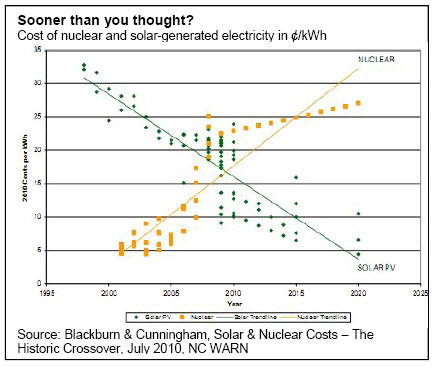
On the other end of the spectrum is solar energy, traditionally considered too costly and only feasible in special applications where the alternatives were even more expensive. But steady technological improvements coupled with increased economies of scale have cut the cost of solar energy, photovoltaics (PVs) as well as concentrated solar power (CSP) over time. Would anyone be surprised that the price trajectories for the two technologies would eventually cross?
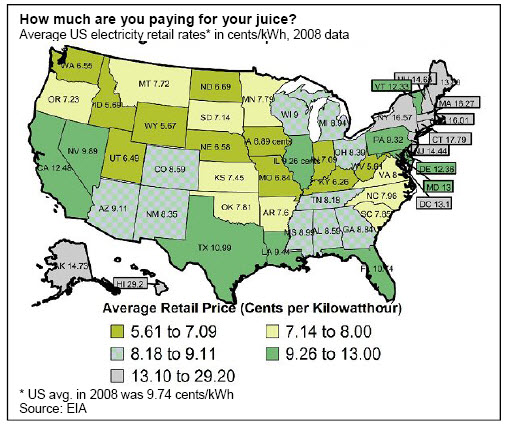
In a report published in July 2010, Duke University’s Emeritus Professor John Blackburn and Sam Cunningham claim that the crossover happened in 2010 at around 16 ¢/kWh. Not exactly cheap, given that the average retail electricity rate in the US is currently around 9.7 (see above map), but a significant milestone nevertheless. Moreover, going forward, the cost of solar generated electricity will continue to decline while nuclear costs are expected to continue to increase. Wonderful news if you are in the solar business, not so good if you are hoping for a nuclear renaissance.
The report, Solar & Nuclear Costs — The Historic Crossover, published by the North Carolina Waste Awareness and Reduction Network (WARN), has received substantial publicity and generated its share of controversy. Few would disagree with the fact that solar costs have been rapidly falling and will continue to do so. There is, however, considerable disagreement on the current and future cost of nuclear power. A number of skeptics took issue with the study’s assumptions, methodology and conclusions regarding the latter. What would life be like without the skeptics?
Solar costs, depending on the specific technology and location — since solar insolation is site-dependent — have certainly been on a downward sloping curve, as documented in numerous studies. Continuous improvements in technology and growing size of installations has resulted in lower per unit costs, which are reflected in lower generation costs in ¢/kWhrs. One can argue about the numbers, but the overall trend is undeniable. And, of course, solar energy benefits from a variety of incentives, subsidies and mandates — which explains its growing penetration in the past few years.
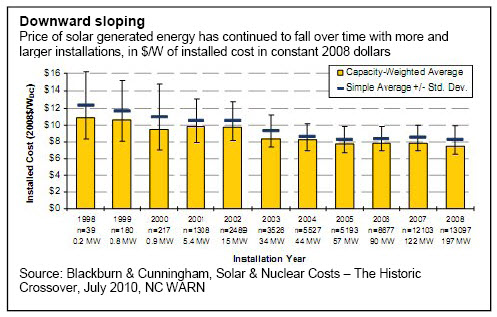
The figure above, based on Ryan Wiser of Lawrence Berkeley National Laboratory (LBL), documents the falling average costs as the number and of size of installed solar capacity has grown over time.
According to the US Department of Energy (DOE), the installed cost of solar technology, currently around $5/Watt, can be expected to drop below $3/Watt by 2015.
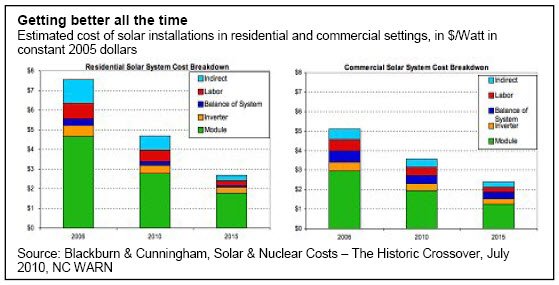
But what about the cost of nuclear power? To answer this question, we must first ask what are the current costs of electricity generated from existing nuclear plants in operation. More important, we must ask what can be said about the costs associated with building new nuclear reactors? The answers to these questions turn out to be far more complicated than estimating the costs of solar energy.
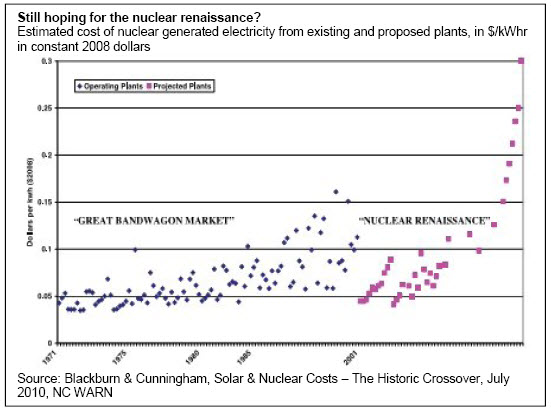
Referring to a June 2009 article by Mark Cooper of the Institute for Energy & the Environment at Vermont Law School, Blackburn & Cunningham conclude that nuclear generated electricity from existing plants is expensive today and likely to become even more expensive for new reactors yet to be built. Cooper, examining various other studies, estimates that the costs associated with new nuclear plants in the 12-20 ¢/kWhr range, with 16 as a mid-range average.
Estimates of nuclear construction costs, which averaged around $3 billion per reactor in 2002, have been regularly revised upward to an average of about $10 billion per reactor today, and these estimates are likely to keep rising, according to Cooper. If one accepts such claims, then investment in solar energy is a better buy, and a better bet given the risks associated with the significant up-front investment in nuclear reactors.
Not the sort of result nuclear enthusiasts want to hear.

